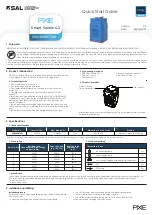
3
MAD mechanism
A multi-active collision occurs if the IPL goes down while the keepalive link is up. To avoid network
issues, the secondary DR device sets all network interfaces to DRNI MAD DOWN state, except for
the following interfaces:
•
Interfaces excluded from the MAD shutdown action by IRF.
•
Interfaces excluded from the MAD shutdown action by DRNI.
The interfaces excluded from the MAD shutdown action by DRNI include system-configured
interfaces and user-configured interfaces. System-configured interfaces include the following:
•
IPP.
•
Aggregation member interfaces if a Layer 2 aggregate interface is used as the IPP.
•
DR interfaces.
•
Management interfaces.
When the IPL comes up, the secondary DR device starts a delay timer and begins to restore table
entries (including MAC address entries and ARP entries) from the primary DR device. When the
delay timer expires, the secondary DR device brings up all network interfaces.
You can use the
display drni mad verbose
command to view detailed information about DRNI
MAD.
DR system setup process
As shown in
, two devices perform the following operations to form a DR system:
1.
Send DRCPDUs over the IPL to each other and compare the DRCPDUs to determine the DR
system stackability and device roles:
a.
Compare the DR system settings. The devices can form a DR system if they have the same
DR system MAC address and system priority and different DR system numbers.
b.
Determine the device roles based on the DR role priority and the bridge MAC address.
c.
Perform configuration consistency check. For more information, see "
."
2.
Send keepalive packets over the keepalive link after primary DR member election to verify that
the peer system is operating correctly.
3.
Synchronize configuration data by sending DRCPDUs over the IPL. The configuration data
includes MAC address entries and ARP entries.
Содержание S6850 Series
Страница 108: ...48 WGE1 0 3 32768 49153 50100 0x7b 0001 0001 0001 ACDEF...
Страница 259: ...21 6 N A 200 6...
Страница 337: ...ii...
















































